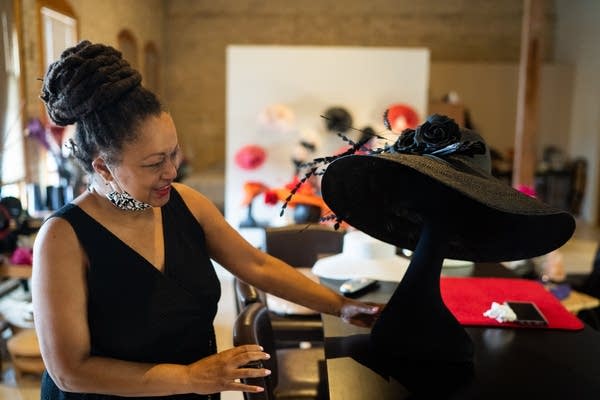In Minnesota, many Black women entrepreneurs missed out on PPP dollars

Go Deeper.
Create an account or log in to save stories.
Like this?
Thanks for liking this story! We have added it to a list of your favorite stories.
Sales at Angie Hall Sandifer’s custom-made hat business in St. Paul came to a crawl this spring when her main moneymaker, the Kentucky Derby, was postponed due to the coronavirus.
She never applied for the Payment Protection Program, which ended last week, because she figured she wouldn’t be eligible. Hall Sandifer has no employees and doesn’t use a traditional bank account for her business.
COVID-19 is hitting Black female entrepreneurs in Minnesota just like everyone else, but many missed on the federal lifeline for small businesses, in part because their operations and business relationships don’t sync with traditional banking.
Black women entrepreneurs are more often underbanked than their white counterparts. This means that they don’t use bank accounts or traditional accounting practices to run their business or have easy access to small business loans. When it came time to apply for PPP loans, a lot of Black female entrepreneurs weren’t ready to apply — or received unreliable information about who qualified.
Turn Up Your Support
MPR News helps you turn down the noise and build shared understanding. Turn up your support for this public resource and keep trusted journalism accessible to all.
“A loan requires a relationship — a relationship with the bank, having an established business account with a bank first of all, and then having a relationship with your banker,” said Tawanna Black, founder and CEO of the Center for Economic Inclusion. “And unfortunately, too many of Black women businesses didn’t have those relationships when PPP loans became available.”

The PPP loans were designed to help people survive the economic impacts of the pandemic by keeping capital flowing through established small business channels. They made it possible for a lot of businesses to keep workers on their payroll and take care of bills they might not have been able to pay otherwise. Many borrowers are eligible to have their loans forgiven.
In Minnesota, more than 102,300 loans were issued to business owners. It’s hard to get a full picture of how that broke down demographically because the main application on the Small Business Administration’s website didn’t ask for that information. Some lenders voluntarily provided those details, and SBA officials say they can’t vouch for their accuracy.
Even so, the disparity is stark. Out of the more than 18,400 borrowers in the state who did provide their race and gender, only 48 businesses owned by Black women received PPP loans, according to the latest SBA data. Agency officials suspect the number of Black female recipients is much higher but could not provide data to support the notion.
On a recent stop in Minnesota, SBA Administrator Jovita Carranza toured an emptied-out Turf Club in St. Paul. She was in town to meet with recipients of PPP loans. Carranza told MPR News she wanted to hear directly from entrepreneurs who received the loans.

As part of the PPP rollout, a representative worked with lenders serving clients in diverse communities and intentionally reached out to business owners that identify as Black, Indigenous and people of color, she said.
“We’ve had in-depth strategies, but can we do a better job? Absolutely,” Carranza said. “The job — the complete job — is not done yet. That’s one of the reasons why we’re here — to engage with minority entrepreneurs and learn, ‘What can we do better?’”
She also acknowledged that “women are the hardest hit” because many don’t have established relationships with lenders.
In the case of Hall Sandifer, the St. Paul milliner, her assumption that the PPP loans were off limits to businesses with no employees wasn’t correct. It was a common misconception, and some say the SBA missed out on opportunities to better tailor the marketing and messaging toward entrepreneurs who didn’t have staff.
“I think it could have been simpler than it was if the education and the branding and framing and language would have spoken to independent contractors and sole proprietors and ... solo entrepreneurs,” said Kenya McKnight Ahad, CEO and founder of the Black Women’s Wealth Alliance in north Minneapolis. “But the marketing and message about PPP was that this is for and for entrepreneurs with employees. Right. And the truth is, it was for both.”
Hall Sandifer has run her business, Angie’s Hats, by herself for 14 years. Her business model doesn’t require the use of a bank account. In fact, it’s cheaper not to. She manages incoming and outgoing payments with Paypal, citing its ease of use for customers and vendors. This meant she didn’t have a relationship with a banker or loan officer who might help her navigate the complexities of the Paycheck Protection Program when it was announced.
But McKnight Ahad did have a relationship with her banker, and she said it was crucial to her success in tapping into the federal program. After McKnight Ahad submitted her information to start the loan process, representatives of the bank helped walk her through the next steps and helped her finalize the application.

“It was on a Thursday, and that [following] Monday, the funds were in my account,” she recalled.
In addition to her experience applying for PPP loans, she also helped other entrepreneurs identify and reach out to lenders so they could access their own PPP funds. While she considers herself lucky, McKnight Ahad says she knows other Black women entrepreneurs who struggled with the process.
One thing she noticed was that banks started to make loans only to existing customers. Then as people started to realize they needed to have accounts with some banks to get loans, many banks stopped opening new accounts.
“That in itself locked out a whole base of people who were not prepared for this,” she said.



